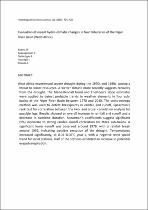 ResearchSpace
ResearchSpace
Evaluation of recent hydro-climatic changes in four tributaries of the Niger River Basin (West Africa)
JavaScript is disabled for your browser. Some features of this site may not work without it.
- ResearchSpace
- →
- Research Publications/Outputs
- →
- Journal Articles
- →
- View Item
| dc.contributor.author |
Badou, DF

|
|
| dc.contributor.author |
Kapangaziwiri, Evison

|
|
| dc.contributor.author |
Diekkrüger, B

|
|
| dc.contributor.author |
Hounkpè, J

|
|
| dc.contributor.author |
Afouda, A

|
|
| dc.date.accessioned | 2017-10-16T11:38:42Z | |
| dc.date.available | 2017-10-16T11:38:42Z | |
| dc.date.issued | 2017-10 | |
| dc.identifier.citation | Badou, D.F., Kapangaziwiri, E., Diekkrüger, B. et al. 2017. Evaluation of recent hydro-climatic changes in four tributaries of the Niger River Basin (West Africa). Hydrological Sciences Journal, vol. 62(5): 715-728. | en_US |
| dc.identifier.issn | 0262-6667 | |
| dc.identifier.uri | http://dx.doi.org/10.1080/02626667.2016.1250898 | |
| dc.identifier.uri | http://www.tandfonline.com/doi/full/10.1080/02626667.2016.1250898 | |
| dc.identifier.uri | http://hdl.handle.net/10204/9654 | |
| dc.description | Copyright: 2016 IAHS. Due to copyright restrictions, the attached PDF file only contains the abstract of the full text item. For access to the full text item, kindly consult the publisher's website. | en_US |
| dc.description.abstract | West Africa experienced severe drought during the 1970s and 1980s, posing a threat to water resources. A wetter climate more recently suggests recovery from the drought. The Mann-Kendall trend and Theil-Sen’s slope estimator were applied to detect probable trends in weather elements in four sub-basins of the Niger River Basin between 1970 and 2010. The cross-entropy method was used to detect breakpoints in rainfall and runoff, Spearman’s rank test for correlation between the two, and cross- correlation analysis for possible lags. Results showed an overall increase in rainfall and runoff and a decrease in sunshine duration. Spearman’s coefficients suggest significant (5%) moderate to strong rainfall–runoff correlation for three sub-basins. A significant lower runoff was observed around 1979, with a rainfall break around 1992, indicating possible cessation of the drought. Temperatures increased significantly, at 0.02–0.05°C year-1, with a negative wind speed trend for most stations. Half of the stations exhibited an increase in potential evapotranspiration. | en_US |
| dc.language.iso | en | en_US |
| dc.publisher | Taylor & Francis | en_US |
| dc.relation.ispartofseries | Worklist;19562 | |
| dc.subject | Climate variability | en_US |
| dc.subject | Climate trends | en_US |
| dc.subject | Breakpoint analysis | en_US |
| dc.subject | Cross-entropy method | en_US |
| dc.subject | Benin | en_US |
| dc.title | Evaluation of recent hydro-climatic changes in four tributaries of the Niger River Basin (West Africa) | en_US |
| dc.type | Article | en_US |
| dc.identifier.apacitation | Badou, D., Kapangaziwiri, E., Diekkrüger, B., Hounkpè, J., & Afouda, A. (2017). Evaluation of recent hydro-climatic changes in four tributaries of the Niger River Basin (West Africa). http://hdl.handle.net/10204/9654 | en_ZA |
| dc.identifier.chicagocitation | Badou, DF, Evison Kapangaziwiri, B Diekkrüger, J Hounkpè, and A Afouda "Evaluation of recent hydro-climatic changes in four tributaries of the Niger River Basin (West Africa)." (2017) http://hdl.handle.net/10204/9654 | en_ZA |
| dc.identifier.vancouvercitation | Badou D, Kapangaziwiri E, Diekkrüger B, Hounkpè J, Afouda A. Evaluation of recent hydro-climatic changes in four tributaries of the Niger River Basin (West Africa). 2017; http://hdl.handle.net/10204/9654. | en_ZA |
| dc.identifier.ris | TY - Article AU - Badou, DF AU - Kapangaziwiri, Evison AU - Diekkrüger, B AU - Hounkpè, J AU - Afouda, A AB - West Africa experienced severe drought during the 1970s and 1980s, posing a threat to water resources. A wetter climate more recently suggests recovery from the drought. The Mann-Kendall trend and Theil-Sen’s slope estimator were applied to detect probable trends in weather elements in four sub-basins of the Niger River Basin between 1970 and 2010. The cross-entropy method was used to detect breakpoints in rainfall and runoff, Spearman’s rank test for correlation between the two, and cross- correlation analysis for possible lags. Results showed an overall increase in rainfall and runoff and a decrease in sunshine duration. Spearman’s coefficients suggest significant (5%) moderate to strong rainfall–runoff correlation for three sub-basins. A significant lower runoff was observed around 1979, with a rainfall break around 1992, indicating possible cessation of the drought. Temperatures increased significantly, at 0.02–0.05°C year-1, with a negative wind speed trend for most stations. Half of the stations exhibited an increase in potential evapotranspiration. DA - 2017-10 DB - ResearchSpace DO - 10.1080/02626667.2016.1250898 DP - CSIR KW - Climate variability KW - Climate trends KW - Breakpoint analysis KW - Cross-entropy method KW - Benin LK - https://researchspace.csir.co.za PY - 2017 SM - 0262-6667 T1 - Evaluation of recent hydro-climatic changes in four tributaries of the Niger River Basin (West Africa) TI - Evaluation of recent hydro-climatic changes in four tributaries of the Niger River Basin (West Africa) UR - http://hdl.handle.net/10204/9654 ER - | en_ZA |





